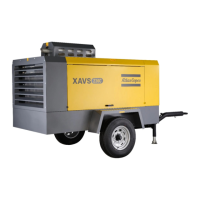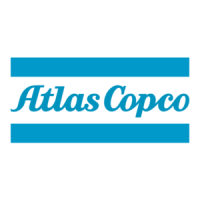- 13 -
SPECIFIC SAFETY PRECAUTIONS
Batteries
When servicing batteries, always wear protecting
clothing and glasses.
1 The electrolyte in batteries is a sulphuric acid
solution which is fatal if it hits your eyes, and
which can cause burns if it contacts your skin.
Therefore, be careful when handling batteries,
e.g. when checking the charge condition.
2 Install a sign prohibiting fire, open flame and
smoking at the post where batteries are being
charged.
3 When batteries are being charged, an explosive
gas mixture forms in the cells and might escape
through the vent holes in the plugs. Thus an
explosive atmosphere may form around the
battery if ventilation is poor, and can remain in
and around the battery for several hours after it
has been charged. Therefore:
- never smoke near batteries being, or having
recently been, charged,
- never break live circuits at battery terminals,
because a spark usually occurs.
4 When connecting an auxiliary battery (AB) in
parallel to the unit battery (CB) with booster
cables: connect the + pole of AB to the + pole of
CB, then connect the - pole of CB to the mass of
the unit. Disconnect in the reverse order.
Pressure vessels
(according to directive 87/404/EEC annex II § 2)
Maintenance/installation requirements:
1 The vessel can be used as pressure vessel or as
separator and is designed to hold compressed air
for the following application:
- pressure vessel for compressor,
-medium AIR/OIL,
and operates as detailed on the data plate of the
vessel:
- the maximum working pressure ps in bar (psi),
- the maximum working temperature Tmax in
°C (°F),
- the minimum working temperature Tmin in °C
(°F),
- the capacity of the vessel V in l (US gal, Imp
gal, cu.ft).
2 The pressure vessel is only to be used for the
applications as specified above and in accordance
with the technical specifications. Safety reasons
prohibit any other applications.
3 National legislation requirements with respect to
re-inspection must be complied with.
4 No welding or heat treatment of any kind is
permitted to those vessel walls which are exposed
to pressure.
5 The vessel is provided and may only be used with
the required safety equipment such as
manometer, overpressure control devices, safety
valve, etc.
6 Draining of condensate shall be performed
regularly when vessel is in use.
7 Installation, design and connections should not be
changed.
8 Bolts of cover and flanges may not be used for
extra fixation.
Safety valves
All adjustments or repairs are to be done by an
authorized representative of the valve supplier (see
also Preventive maintenance schedule).

